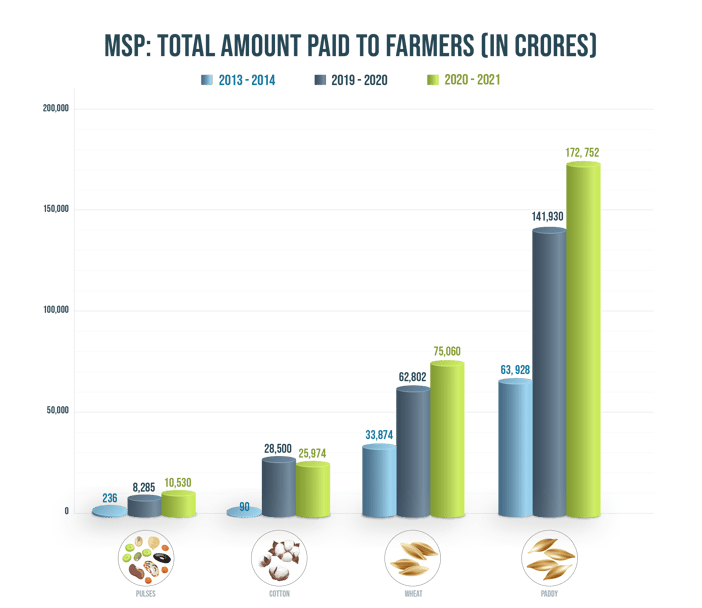The Union Budget 2021 that Finance Minister Nirmala Sitharaman had presented on February 1st included, among others, several key announcements for the agriculture sector that focus on inclusive development to revive the economy. They are summarised below.
Agricultural credit
To ensure higher availability of credit for farmers, as well as those in the animal husbandry, dairy, and fisheries sectors, the government has increased the target for agricultural credit to ₹16.5 lakh crores in FY 2021–22 from ₹15 lakh crores in the previous year. Here is what this could mean for India’s agri-fintech startups.
Operation Green Scheme
The scheme was first introduced in the Union Budget 2018–19 to stabilise the supply and the price of tomato, onion, and potato (TOP) crops throughout the country round the year without the risk of price volatility. The Finance Minister has proposed in Budget 2021–22 to extend the scheme to include 22 perishable products. This move is expected to boost the value addition in agricultural and its allied products and their exports.
Integrating additional mandis with e-NAM
The Finance Minister has proposed the integration of an additional 1,000 mandis with the National Agriculture Market (eNAM), a pan-India electronic trading portal that networks the existing State-run Agricultural Produce Marketing Committees (APMCs) mandis. The decision was made considering that nearly 1.68 crore farmers are already registered, and ₹1.14 lakh crores of trade value has been realised through them, which highlights the transparency and competitiveness that e-portal delivers. Further, the Minister has proposed to make the Agriculture Infrastructure Fund available to APMCs for strengthening their infrastructure facilities.
Rural Infrastructure Development Fund
The Budget 2021 proposes to increase the allocation to the Fund from ₹30,000 crores the previous year to ₹40,000 crores this year, which will provide a boost to rural infrastructure projects across the country. Additionally, allocation to the Micro-Irrigation Fund (MIF), which the NABARD had instituted to achieve the ‘per drop more crop’ goal, has been doubled to ₹10,000 crores to promote efficient use of water for agriculture.
Extension of the SVAMITVA Scheme
The “Survey of Villages and Mapping with Improvised Technology in Village Areas (SVAMITVA) scheme” was introduced to bring transparency in property ownership in villages. The pilot phase covered eight states (Haryana, Karnataka, Madhya Pradesh, Maharashtra, Rajasthan, Punjab, Uttar Pradesh, and Uttarakhand) for the year 2020–21 and included approximately 1 lakh villages. This scheme is now being extended to cover all states and UTs during FY 2021–22. The potential benefit it offers is that the digitisation of personal identity, agricultural land, and residential property in rural areas through the scheme will facilitate transparent transactions in land parcels. Non-farm related activities will also benefit from a clear title and the removal of land supply constraints. Up till now, about 1.80 lakh property-owners in 1,241 villages have been provided cards.
Minimum Support Price (MSP)
Reaffirming the Government’s commitment to the welfare of the farmers, the Finance Minister stated that the MSP regime has evolved to ensure that it is at least 1.5 times the cost of production across all commodities. There has also been a steady increase in the procurement of commodities, which has resulted in substantial improvement in the payment made to farmers.

Enhanced credit flow for activities allied to agriculture
Under the ‘Stand Up India’ scheme, the Minister has proposed to include loans for activities allied to agriculture, too, apart from the existing credit to manufacturing, services, or trading sectors. The Scheme was initiated to facilitate bank credit between 10 lakhs and 1 crore to at least one borrower from the Scheduled Caste (SC) or Scheduled Tribe (ST) and at least one woman per bank branch.
Custom Duty Rationalisation
With the twin objective of strengthening domestic manufacturing and helping India get onto the global value chain and export value-added products better, a revised and distortion-free customs duty structure is proposed to be implemented from October 1, 2021. In a move to benefit farmers, customs duty on cotton will be raised from nil to 10%, and on raw silk and silk yarn from 10% to 15%. The proposed increase in customs duty on denatured ethyl alcohol (from 2.5% to 5%) and on maize bran and de-oiled rice bran cake (0 to 15%) will further benefit sugarcane, maize, and paddy growers respectively.
Agriculture Infrastructure and Development Cess (AIDC)
The AIDC has been proposed on specified goods, both on the customs side as well as on the excise side. The cess addresses the immediate need to improve agricultural infrastructure to enable higher production and enhanced remuneration for the farmers while also conserving and processing agricultural output efficiently. With the introduction of this Cess, the Basic Customs Duty (BCD) rates have been reduced on certain items. Furthermore, to compensate for the imposition of the Cess on petrol and diesel, the Basic excise duty (BED) and Special Additional Excise Duty (SAED) rates have also been reduced on them. The reduction of the above rates in Budget 2021 ensures that the consumer does not bear any additional burden on most of the items.
Aquaculture
Development of fishing harbours and fish-landing centres
Significant investments have been proposed to establish modern fishing harbours and fish landing centres in select regions. In particular, five of the principal fishing harbours, i.e., Chennai, Kochi, Visakhapatnam, Paradip, and Petuaghat, will be promoted as hubs of economic activity. Inland fishing harbours and fish-landing centres will also be developed along the banks of rivers and waterways.
Multipurpose Seaweed Park
With seaweed farming emerging as an alternative source of sustainable income and large-scale employment opportunities for coastal communities, the Finance Minister has also proposed the setting up a Multipurpose Seaweed Park in Tamil Nadu to promote seaweed cultivation.
The Budget 2021 promises several measures to strengthen rural and agriculture infrastructure development through value generation and market realisation. Be it the improved availability of credit for farmers and the increased allocation to the Rural Infrastructure Development Fund, or the development of infrastructure for the aquaculture sector, the proposals put forward in the Budget hold promise of ensuring enhanced opportunities and better profits for farmers. These provisions, when implemented effectively, will ensure higher incomes for farmers as well as promote diversification.











